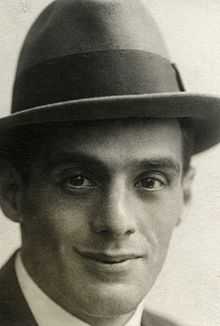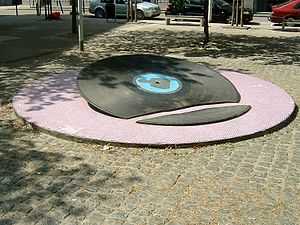Louis Davids
| Louis Davids | |
|---|---|
 | |
| Born |
Simon David 19 December 1883 Rotterdam, Netherlands |
| Died |
1 July 1939 (aged 55) Amsterdam, Netherlands |
| Nationality | Dutch |
| Known for | Cabaret, Variety shows |

Simon David (19 December 1883 — 1 July 1939) better known as Louis Davids was a Dutch cabaretier and revueartist and is widely considered one of the Netherlands biggest names in performing arts.
Biography
Louis Davids was born in Rotterdam as son of the comedian and café owner Levie David and Francina Terveen (deceased in 1927) in a poor Jewish family of eight children. His parents were performing artists and Louis sang from the age of eight years at all the state fairs with his brother Hakkie who played the Piano. Until he was 13 years old he also performed with his sister Rika in Rotterdam ouside of the fair. After an argument with his father he left for England to be an assistant to a Magician. Returning to Rotterdam a year later, returning home with a lot more experience in variety theater. Together with his sister Rika he managed to secure a job ouside of the fair, working at the theater Pschorr, on Een reisje langs den Rijn and We gaan naar Zandvoort aan de zee amongst others, him and his sister then moved to Amsterdam to work with theater director Frits van Haarlem in Carré with plenty success in creating revues after English fashion. He furthered his success in revue in 1909 working with Henri ter Hall.

After Rika married English magician John Weil and moved to England she parted from the successful duo. Louis then formed another duo, after an unsuccessful attempt at a career as a magician, this time with his younger sister Henriëtte (Heintje). The second Davids duo was a success once more. The husband of Heiintje, Philip Pinkhof, wrote the roles that Davids and his ster would play.
In 1906 Louis married Rebecca Kokernoot with whom he had a daughter, he was however unhapy in his marriage. While on tour Davids made the acquaintance of Margie Morris who had moved to the Netherlands in 1913. Up until 1922 Louis and Maggie formed the duo "He, She and the piano", where Maggie would take on the role as composer. The comedic repertoire soon becomes known across the land as what is now known as the genre Levenslied. A famous song from this period is De Jantjes which was also released as a silent film in 1922, and as a full motion picture in 1934. Between 1922 and 1926 Davids was the director of the Casino Theater in Rotterdam, but the job of a director does not hold his attention for long.
In 1929 Louis Davids appeared in the revue Lach en vergeet with the song which would prpbably become his most popular title De kleine man. It was written by Jacques van Tol, with whom Davids would work closely until his death in 1939. Him and Van Tol agreed that Tol would remain anonymous as songwriter after 1929.
Despite Davids being from Rotterdam, he was a popular performer of the Amsterdam Jordan repertoire. David was the founder of the career of some big names like Wim Kan and Corry Vonk, Wim Sonneveld and Cabaret Ping Pong.
In 1937 Louis Davids had to give up his work at the Kurhaus of Scheveningen-cabaret due to asthma. His early passing at the age of 55 was largely due to asthma. Davids was cremated in Driehuis. His ashes were interred in the columbarium of the crematorium. The remains of his brother Rido and his sister Heintje Davids were later placed next to him.
Repertoire
A small group of his repertoire include: De Kleine Man, Mina, Kindervragen, Lintjesregen, Sally Met De Roomijskar, Wat een meisje weten moet, Weekend in Scheveningen, Moeder heeft haar rijbewijs, Naar de bollen, De begrafenis van ome Manus, De Scheveningse zee, Bridgeclub Kijk voor je, De Sweepstake, Waarom zou ik niet, De Olieman heeft een Fordje opgedaan, Ich küsse ihre Hand Madame, De Voetbalmatch, Weet je nog wel oudje, Moeder wil dansen, Als je voor een dubbeltje geboren bent, In de Jordaan.
Legacy
In 2010 the Netherlands Comedy Theater performed a play about Davids titled Liedjes van Louis Davids.
See also
External links
- Louis Davids on a life long in Theater
- Biography of Louis Davids on Historici.nl
- Website of the presentation Liedjes van Louis Davids